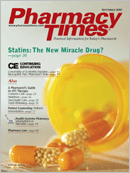Publication
Article
Pharmacy Times
Case Studies
CASE ONE:
PS, a 45-year-old woman, is meeting with an anesthesiologist to discuss her pending laparoscopic cholecystectomy. The anesthesiologist obtains a complete medical history from PS.
According to her records, PS's history is significant for type 2 diabetes mellitus, hypertension, coronary artery disease, hyperlipidemia, and gastroesophageal reflux disease. Her surgical history includes coronary artery bypass grafting (CABG) and mediastinal exploration for a sternal infection post-CABG. As a child, she underwent a tonsillectomy and an appendectomy.
PS lives with her husband and 2 children. She denies smoking or alcohol consumption. She drinks 5 cups of coffee daily.
Her mother and sister both had cholecystectomies when they were in their early 40s. Her mother also has type 2 diabetes.
PS denies any other contributory history. PS's current medications include:
Her preadmission laboratory results were reported as follows:
As the anesthesiologist discusses the surgery and endotracheal anesthesia with PS, he considers his plan for her surgery. He is aware that the hospital's formulary includes the following neuromuscular blocking agents: cisatracurium, vecuronium, atracurium, and succinylcholine.
Due to her elevated potassium levels and cardiac history, the anesthesiologist decides not to use which neuromuscular blocking agents?
CASE TWO:
The first-year resident is called to the postanesthesia care unit by the nurse. The nurse is concerned about a patient she just received from the operating room. She explains to the resident that the anesthesiologists and surgeons are all busy in the operating rooms due to the recent arrival of multiple trauma patients. Without even waiting to hear what the nurse was observing in the recovery room, the anesthesiologist told her that the resident would need to handle whatever was happening in there.
The nurse begins to describe to the resident what she has observed. Shortly after arriving in the postanesthesia care unit, the patient's blood pressure and heart rate began to rise. His temperature also appears to be rising. The patient is also tachypneic and hypercarbic. According to the most recent arterial blood gas reading, the patient is acidotic.
Since the resident does not seem to understand what these symptoms might suggest, the nurse gently informs him that she believes the patient may have malignant hyperthermia, a life-threatening syndrome that occurs during or immediately after general anesthesia.
Along with considering how to treat the condition, the resident wonders what caused the condition to develop. What causes malignant hyperthermia?
Dr. Schlesselman is a clinical pharmacist based in Niantic, Conn.
Click Here For The Answer ----------->
[-]
CASE ONE: Succinylcholine, a depolarizing neuromuscular blocking agent, is typically avoided in patients with hyperkalemia. Depolarization of cells causes the release of potassium ions, often increasing the patient's serum potassium levels. The use of a nondepolarizing neuromuscular blocking agent would avoid this complication. Some nondepolarizing neuromuscular blocking agents have significant cardiovascular adverse effects. Mivacurium and atracurium can cause reductions in blood pressure due to histamine release. Pancuronium and rocuronium exhibit vagolytic effects, causing tachycardia. Cisatracurium and vecuronium do not have cardiovascular side effects.
CASE TWO: Malignant hyperthermia, a genetically inherited disorder of the skeletal muscles, can be triggered by exposure to volatile inhalational anesthetic agents or succinylcholine. Exposure to these agents causes excessive release of calcium from skeletal muscles, leading to muscle rigidity, hypermetabolism, and cell death. Patients will begin to exhibit symptoms during or immediately following surgery, typically in the recovery room. Symptoms include fever, elevated blood pressure, respiratory or metabolic acidosis, tachycardia, tachypnea, and hypercarbia.
toggle(getObject('exp1048685570_link'), 'exp1048685570');







